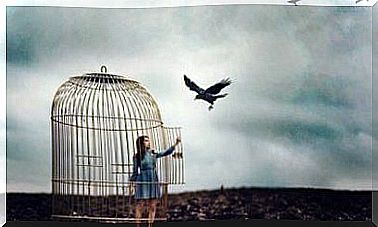Anorexia From Psychodrama

The psychodrama approach to anorexia is a good way to try to achieve a deeper change and overcome those resistances that sometimes delay improvements in therapy. We are talking about disorders such as anorexia or bulimia, where time is crucial, as an unsuccessful intervention can have fatal consequences.
The treatment of eating disorders (ED) is sometimes complicated by working with the population with the highest incidence: adolescent girls. In addition to the disorder itself, your insecurities, your shame or your fear of speaking can be mixed. This happens in both individual and group therapies.

What does psychodrama offer?
Psychodrama is a psychotherapeutic procedure developed by Jacobo Levy Moreno whose origin could be found in theater, psychology and sociology. It is, from a technical point of view, a method of action and interaction, its main core being dramatization.
Precisely for this reason, unlike other psychotherapies where the main interest is focused on verbalization, psychodrama expressly makes the body participate in its various expressions, and makes it interact with other bodies.
Some of the techniques that this type of therapy can offer us for the treatment of anorexia nervosa or bulimia nervosa are explained below.
Silhouette technique: this is not my body
The first to use this technique was Askevold (1975), who found an overestimation of the size of the shoulders, hips and waist.
Rojas (2013) used this psychodramatic technique with a group of women between 14 and 52 years old with restrictive anorexia nervosa. The techniques focused on the work of two common factors that tend to occur in eating disorders: the rejection of the body itself and the distortion of body image.
The body image of one’s own body is not made only in relation to its objective measurements. We must take into account the assessment that is made in comparison to the reference models, in addition to the thoughts and emotions that this same produces in us, as such, the consequences of our assessment.
Therefore, alterations in body image may be due to cognitive (dissatisfaction with one’s own body) or perceptual (inaccuracy in estimating one’s own body) alterations.
In the silhouette technique, the person to whom it is administered has to draw their silhouette to life scale on a piece of paper. Next, he has to lie down on the silhouette that he has just drawn, and another person contour the profile of his body on top.
Thus, this technique allows us to see if the woman has a distortion of her body image and to see the degree of this distortion (diagnostic function).
Role reversal: a talk with my stomach
Prosen (2016) carried out a study with people with bulimia nervosa, made up of a heterogeneous group of men and women. In this case, there was no approach to anorexia from psychodrama, but from bulimia.
In role reversal, the person exchanges his role with a partner, who becomes an auxiliary ego. This allows the protagonist to interact with himself in concrete situations and face his own thoughts, behavior or other scenes in his life where food, his body and his emotions play an essential role.
It is a very valuable technique since it allows the person to see themselves through the eyes of another person. The role of the auxiliary ego is to shape thoughts and feelings that the protagonist is not yet capable of expressing, allowing the latter to confront them. Despite having two actors, the protagonist enters into a dialogue with himself on stage.
For example, the person can carry on a conversation with his stomach. This allows you to discover the unconscious thoughts that this part of your body produces and to recognize the destructive thoughts that it generates as a result of these thoughts.
In this therapeutic group, the change of roles allowed the protagonist to realize how destructive it was to try to control his body using compensatory behaviors. The technique proved useful in stimulating the patient to take control of his impulses, feelings, and needs.
Role reversal in anorexia nervosa
In another study, carried out at the University Psychiatric Hospital in Ljubljana, with a group of mostly women with anorexia nervosa, the role reversal technique was also used.
At the beginning, they all began wanting to be auxiliary roles and not protagonists, but it was observed that throughout the therapy, excluding a fifth of them, they all assumed the protagonist role at least twice.
It was also seen how the most problematic themes of women coincided, the primary family being the most recurrent. Role changes were carried out with family members, where women had to confront themselves from the point of view of a member of their close family.

Drawing technique: we are not so different
Shisslak, C., Schnaps, L. and Swain, B. (1986) conducted a study with several groups composed of 8 patients with anorexia or bulimia nervosa, both disorders combined, of heterogeneous ages.
The drawing technique consisted of giving each person a piece of paper and colors. They wanted them to draw their respective families at the time when their eating disorder had started to develop.
As if it were a genogram, they were asked to draw circles to represent their family members and to represent their relationships with solid lines and broken or blurred lines. Other important people who were unfamiliar should also be included, along with significant settings, such as school or work.
The conclusions they drew from this experience were powerful; many patients saw that they shared a lot with their peers; and that they had very similar family relationships, such as distant or very controlling parents or abusive situations at home. These types of experiences are infrequent when these types of activities are not carried out.
“Who Am I?” Technique
The “Who Am I?” refers to answering this same question, which in patients with eating disorders is usually something very threatening, due to the distorted sense they have of themselves.
Rather than face this question verbally on their own, the task indicated that they were to use sounds, photographs, words, music, colors, sculpture, or dance to answer this question. The fact of doing this activity in a group facilitated the expression of emotions.
In this way, the treatment of bulimia and anorexia is proposed from psychodrama, which offers us tools that flee from the conventional to achieve the same objectives. These are: emotional expression, insight, the search for cognitive distortions, the change of irrational thoughts.
In addition, it allows the person to have a conversation at the end with that “being” that he has been avoiding, on occasions, for many years: his own body.









